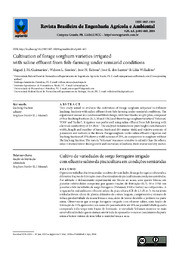Cultivation of forage sorghum varieties irrigated with saline effluent from fish-farming under semiarid conditions.
Cultivation of forage sorghum varieties irrigated with saline effluent from fish-farming under semiarid conditions.
Author(s): GUIMARÃES, M. J. M.; SIMOES, W. L.; TABOSA, J. N.; SANTOS, J. E. dos; WILLADINO, L.
Summary: This study aimed to evaluate the cultivation of forage sorghum subjected to different leaching fractions with saline effluent from fish-farming under semiarid conditions. The experiment was set in a randomized block design, with four blocks, in split plots, composed of four leaching fractions (0; 5; 10 and 15%) and three forage sorghum varieties (Volumax), ?F305? and ?Sudão?). Irrigation was performed using saline effluent from fish farming with electrical conductivity of 2.5 dS m-1. The analyzed variables were: plant height; stem diameter; width, length and number of leaves; fresh and dry matter yield, and relative contents of potassium and sodium in the shoots. Forage sorghum under saline effluent irrigation and leaching fraction of 15% shows a yield increase of 25%, in comparison to sorghum without the leaching fraction. The variety Volumax was more sensitive to salinity than the others, since it showed lower shoot growth and low values of leaf area, fresh matter and dry matter.
Publication year: 2016
Types of publication: Journal article
Unit: Embrapa Semi-arid Region
Observation
Some of Embrapa's publications are published as ePub files. To read them, use or download one of the following free software options to your computer or mobile device. Android: Google Play Books; IOS: iBooks; Windows and Linux: Calibre.
Access other publications
Access the Agricultural Research Database (BDPA) to consult Embrapa's full library collection and records.
Visit Embrapa Bookstore to purchase books and other publications sold by Embrapa.

